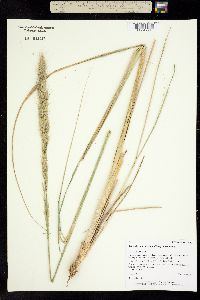Achnatherum robustum
|
|
|
|
Family: Poaceae
Sleepy Rice Grass, more...sleepygrass, sleepy grass
[Stipa robusta (Vasey) Scribn., moreStipa vaseyi Scribn., Stipa viridula var. robusta Vasey] |
Plants cespitose, not rhizom-atous. Culms 100-230 cm tall, 2-4.5 mm thick, mostly glabrous, often pubescent below the nodes, the pub-escence antrorse or retrorse; nodes 4-5. Basal sheaths mostly glabrous, margins usually ciliate distally; collars hairy, those of the flag leaves densely hairy, hairs 0.5-2 mm, sides glabrous; basal ligules 1-2 mm; upper ligules to 4 mm, truncate, rounded, or obtuse, glabrous; blades 6-10 mm wide, glabrous, abaxial surfaces smooth, adaxial surfaces prominently ribbed, ribs scabrous. Panicles 15-30 cm long, 0.8-3.5 cm wide; branches straight, appressed to ascending, lower branches 3-9 cm. Spikelets appressed to the branches. Glumes subequal, 9-11.5 mm long, 1-1.4 mm wide; florets 5.9-8.5 mm long, 0.9-1.2 mm thick, fusiform, terete; calluses 0.3-1 mm, blunt; lemmas evenly hairy, hairs at midlength 0.3-0.8 mm, apical hairs to 1.5 mm; awns 20-32 mm, persistent, twice-geniculate, scabridulous to scabrous, scabrules to about 0.1 mm, longest on the middle segment, terminal segment straight; paleas 3.7-5.6 mm, 2/3-3/4 as long as the lemmas, hairy, hairs about 0.5 mm, not exceeding the apices, veins terminating below the apices, apices rounded; anthers 4-5 mm, dehiscent, penicillate. Caryopses 5-6 mm. 2n = 64. Achnatherum robustum grows on dry plains and hills, in open woods and forest clearings, and along roadsides, from Wyoming through Colorado to Arizona, New Mexico, and northern Mexico. Records from Kansas represent recent introductions; it is not clear whether the species has persisted there. Achnatherum robustum is sometimes confused with A. nelsonii subsp. dorei and Nassella viridula; it differs from both in the densely hairy collars of its flag leaves. Although not widely available, it has potential as an ornamental grass, particularly in arid regions with cold winters. The English-language name refers to the effect some samples, particularly those from the Sacramento and Sierra Blanca mountains, New Mexico, have on livestock, especially horses and cattle. "Mildly poisoned animals are dejected, inactive, and withdrawn; severely poisoned animals lie on their sides in a profound slumber" (Cheeke and Shull 1985). The active ingredient is diacetone alcohol (Epstein et al. 1964). Dr. David Bogler , USDA NCRS PLANTS Database Perennials, Terrestrial, not aquatic, Stems nodes swollen or brittle, Stems erect or ascending, Stems caespitose, tufted, or clustered, Stems terete, round in cross section, or polygonal, Stem internodes hollow, Stems with inflorescence 1-2 m tall, Stems, culms, or scapes exceeding basal leaves, Leaves mostly basal, below middle of stem, Leaves mostly cauline, Leaves conspicuou sly 2-ranked, distichous, Leaves sheathing at base, Leaf sheath mostly open, or loose, Leaf sheath smooth, glabrous, Leaf sheath hairy at summit, throat, or collar, Leaf sheath and blade differentiated, Leaf blades linear, Leaf blades 2-10 mm wide, Leaf blades mostly flat, Leaf blade margins folded, involute, or conduplicate, Leaf blades mostly glabrous, Ligule present, Ligule an unfringed eciliate membrane, Inflorescence terminal, Inflorescence a contracted panicle, narrowly paniculate, branches appressed or ascending, Inflorescence solitary, with 1 spike, fascicle, glomerule, head, or cluster per stem or culm, Flowers bisexual, Spikelets pedicellate, Spikelets dorsally compressed or terete, Spikelet less than 3 mm wide, Spikelets with 1 fertile floret, Spikelets solitary at rachis nodes, Spikelets all alike and fertille, Spikelets bisexual, Spikelets disarticulating above the glumes, glumes persistent, Spikelets disarticulating beneath or between the florets, Rachilla or pedicel glabrous, Glumes present, empty bracts, Glumes 2 clearly present, Glumes equal or subequal, Glumes equal to or longer than adjacent lemma, Glumes 3 nerved, Lemma coriaceous, firmer or thicker in texture than the glumes, Lemma 5-7 nerved, Lemma body or surface hairy, Lemma apex acute or acuminate, Lemma distinctly awned, more than 2-3 mm, Lemma with 1 awn, Lemma awn 2-4 cm long or longer, Lemma awned from tip, Lemma awn twisted, spirally coiled at base, like a corkscrew, Lemma awn twice geniculate, bent twice, Lemma margins inrolled, tightly covering palea and caryopsis, Lemma straight, Callus or base of lemma evidently hairy, Callus hairs shorter than lemma, Lemma surface pilose, setose or bristly, Palea present, well developed, Palea membranous, hyaline, Palea shorter than lemma, Stamens 3, Styles 2-fid, deeply 2-branched, Stigmas 2, Fruit - caryopsis, Caryopsis ellipsoid, longitudinally grooved, hilum long-linear.
|
|
|
|























































































